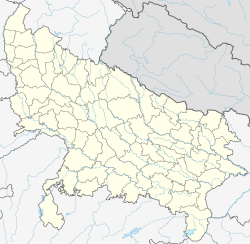Jajmau
Sub-metropolis in Uttar Pradesh, India From Wikipedia, the free encyclopedia
Jajmau also known as Jajesmow during British Era, is a suburb of Kanpur, India. It is situated on the banks of the Ganges River. Jajmau is an industrial suburb. It has the population of about 652,831 according to the census of 2011. The area comes under the jurisdiction of Kanpur metropolitan area.
Jajmau
Jajesmow | |
|---|---|
sub-metropolis | |
| Nickname: Leather Cluster of Kanpur | |
| Coordinates: 26.46°N 80.35°E | |
| Country | India |
| State | Uttar Pradesh |
| District | Kanpur District |
| Population (2011) | |
• Total | 652,831 and 1,600,000 (2,050 estimated)[1] |
| Languages | |
| • Official | Hindi, Bengali, Urdu, Bhojpuri, Malayalam, Punjabi & Kannauji (predominantly) |
| Time zone | UTC+5:30 (IST) |
| PIN | 208 XXX |
| Vehicle registration | UP-78 |
| Literacy | 80%% |
| Lok Sabha constituency | Kanpur, Akbarpur, Unnao |
| Vidhan Sabha constituency | Kanpur Cantonment, Maharajpur, Unnao |
Name
According to Paul Whalley, the name Jājmaū may be related to Sanskrit yajña, meaning "sacrifice", which became Old Hindi jaj. It could have gotten this name because the site was originally given to a priest who performed a sacrifice. The ending -maū could come from Sanskrit maryādā, meaning "shore" or "bank", or it could be a contraction of the name of the mahuā tree.[2]: 4–7
Geography
The city's coordinates are 26.4670° North and 80.3500° East, placing it 83 km from Lucknow. Jajmau is situated near the Ganges. The sub metro area of 40 km2 extends from Bibipur in the south to Chandar Nagar in the north and Ramadevi in the east to Jajmau extension in the west.
History
The archaeological site of Jajmau is a large mound on the banks of Ganges river, known as the Jajmau ka tila.[3] Copper hoard artefacts and Painted Grey Ware (PGW) sherds were found from the surface deposits of the mound. In 1956, at the time of the construction of the national highway and Jajamu bridge, remains of an ancient settlement were discovered there. Excavations were carried out by the Archaeological Survey of India and the Uttar Pradesh State Archaeology Department in 1956-58 and 1973-78. During the excavations in 1977-78, an ivory seal with Vasalas inscribed in Brahmi was found. A historian, Girish Chandra Singh, said that Vasalas is an epithet of the ancient Maurya emperor Chandragupta.[4]
Climate
Summarize
Perspective
| Jajmau[4] | ||||||||||||||||||||||||||||||||||||||||||||||||||||||||||||
|---|---|---|---|---|---|---|---|---|---|---|---|---|---|---|---|---|---|---|---|---|---|---|---|---|---|---|---|---|---|---|---|---|---|---|---|---|---|---|---|---|---|---|---|---|---|---|---|---|---|---|---|---|---|---|---|---|---|---|---|---|
| Climate chart (explanation) | ||||||||||||||||||||||||||||||||||||||||||||||||||||||||||||
| ||||||||||||||||||||||||||||||||||||||||||||||||||||||||||||
| ||||||||||||||||||||||||||||||||||||||||||||||||||||||||||||
The climate of Jajmau is hot in summer and warm in winter. Jajmau experiences heavy fog in December and January. Rains appear between July and September, almost at the end of the regular monsoon season. Some rainfall is recorded during the harvest season of March–April.[citation needed]
Religion
Sister cities
- Hebron, Palestine[citation needed]
Notes
Wikiwand - on
Seamless Wikipedia browsing. On steroids.
